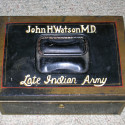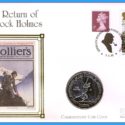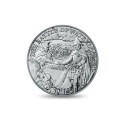A Scion Society of The Baker Street Irregulars

Data! Data! Data! – The Solitary Cyclist
“‘Data! Data! Data!‘ he cried impatiently. ‘I can’t make bricks without clay.’”
– The Adventures of The Copper Beeches (COPP)
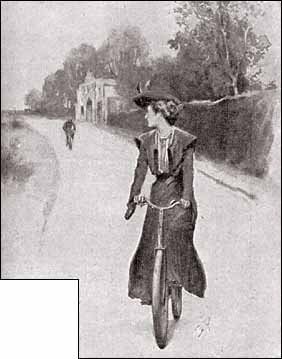
This column is composed of material (Data!) developed for a short course called Appreciating Sherlock Holmes that I taught twice a year in the Community Education Life Enrichment Program for a local community college. It is composed of “points of information” that are common to many / most / all of the 60 Canonical stories.
The information here has been researched by me or borrowed / stolen from many efforts of other Sherlockians.
I like this story much more than many – – – can’t explain why.
HERE GOES This month’s story The Adventure of the Solitary Cyclist
CHRISTOPHER MORLEY SAID . . .
The beautiful Violet Smith, a music teacher, was not as solitary as she wished to be. As she rode on her bicycle through the picturesque countryside of Surrey she was mysteriously pursued by another rider. Holmes though it might be only “some trifling intrigue” and sent Watson to investigate. Later Sherlock went himself, and got into a fist fight.
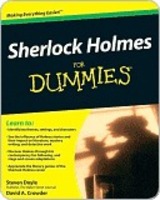 DUMMIES SHORT SUMMARY (From Sherlock Holmes for Dummies by Steven Doyle & David Crowder)
DUMMIES SHORT SUMMARY (From Sherlock Holmes for Dummies by Steven Doyle & David Crowder)
“Violet Smith is being followed. Having no one to turn to, she appeals to Holmes for advice. This creepy story of a young woman being stalked by bicycle on a lonely country lane is a classic.”
PUBLISHING HISTORY
- This was the 31st of the 60 stories publishes
- It was first published in The Strand Magazine in January 1904
- It was Published in the U.S. in Collier’s Weekly, December 26, 1903
- It is part of The Return of Sherlock Holmes collection published by George Newnes, Ltd., London, 1905 and by McClure Phillip & Co., New York, 1905
- The British Illustrator was Sidney Paget
- The U.S. Illustrator was Frederick Dorr Steele
HOW MANY WORDS?
According to C. E. Lauderback, 1960 – – found on SHERLOCKIAN.NET website created by Chris Redmond and at 7,908 words SOLI has the 29th most words (#1 is VEIL – 4,499, #56 if NAVL – 12,701).
THE BEST OF SHERLOCK HOLMES (How do Sherlockians rate this story?)
1927 – Arthur Conan Doyle did not include on his list of 12 favorites
1959 – The Baker Street Irregulars did not include on their list of best 10 short stories
1999 – The Baker Street Irregulars voted it 25th of the 56 short stories
1999 – The Sherlock Holmes Society of London voted it 19th of the 56 short stories
CLASSIFYING THE CASE (From the Wandering Gipsies of Grimpen Mire of Decatur, Alabama)
This case is one of 3 classified as a disappearance by abduction. The other two were LADY and PRIO.
CHRONOLOGICALLY SPEAKING
Doyle was often very vague about stating WHEN the tale took place and included few contemporary references to help. Whether this was done intentionally or unthinkingly, the dating of events in the Canon is a very popular pastime pursued by several of our “scholars” researching and justifying their results to no end. We will again default to William Baring-Gould’s dating of Saturday, April 13 to Saturday, April 20, 1895 which makes it the 35th of the 60 stories in time. This would make Holmes 41 and Watson 43.
WHAT ELSE HAPPENED IN YEAR 1895?
It is always interesting to see what else in happening at the same time as the stories.
- Freetown, Sierra Leone, granted municipal status and privileges.
- Anglo-French interests begin to conflict in Nile Valley.
- Construction of Uganda railway commenced.
- British East Africa Company surrenders Kenya as British protectorate.
- Liberals defeated at general election, Salisbury again becomes prime minister.
- Compulsory retirement of aged Duke of Cabridge as Commander-in-Chief of British Army.
- First automobile exhibition in London.
- Electrification of first mainline railway.
- Japan takes Formosa (Taiwan).
- Germany, France, and Russia unite to compel Japan to return Liaotung peninsula to China.
- Treaty of Simonoseki, end of Sino-Japanese war.
- Cuban rebellions begin, U.S. protests brutal suppression.
- Dreyfus refused new trial by French President Faure.
- National League founded in Poland; aimed at autonomy under Russian suzerainty.
- Armenian demonstration in Constantinople leads to massacre of 50,000 Armenians.
- Introduction of diphtheria antitoxin.
- Completion of Kiel Canal (61 miles) makes Germany North Sea power.
- Oscar Wilde’s The Importance of Being Earnest Later that year, Wilde is imprisoned.
- Corelli publishes The Sorrows of Satan.
- G. Wells publishes The Time Machine.
- Wilhelm Konrad Rontgen, German physicist, experiments with Crooke’s tubes and discovers X-rays.
- Ramsey obtains helium, first identified by its spectrum in the sun, in 1868.
- On December 28th, in the Hotel Scribe, in Paris, the first public cinema show takes place.
- Thomas Armat, of Washington, develops modern cinema projection.
- King Gillette (U.S.) invents safety razor.
- Wireless telegraphy is demonstrated.
HOLMES AND WATSON – PERSONAL INFO
As in most cases our heroes reside at 221B
DRAMATIS PERSONAE
Our cast is a varied collection of interesting people
- Violet Smith, the solitary cyclist.
- Smith, Violet’s mother
- James Smith, Violet’s father; deceased; formerly orchestra leader at the Imperial Theater.
- Ralph Smith, Violet’s uncle who went to South Africa 25 years ago and has not been heard from since.
- Bob Carruthers, South African miner. A widow.
- Jack Woodley, South African highwayman and ally of Carruthers.
- Williamson, a defrocked clergyman who had leased Chiltern grange. An ally of Woodley.
- Cyril Morton, Violet’s fiancé. An electrical engineer.
- Dixon, Carruthers’ housekeeper.
- Peter the groom.
- Miss Carruthers, Bob’s daughter. No first name given. (given the name Sarah in Granada/Brett version)
“QUOTABLE SHERLOCK”
- Violet Smith to Holmes about Woodley – “He made odious love to me”
- Violet Smith to Holmes about Mr. Carruthers – “He has never said anything. He is a perfect gentleman. But a girl always knows.”
- Holmes to Watson about Violet Smith – “It is part of the settled order of nature that such a girl should have followers.”
- Holmes to Watson about his encounter with Woodley – “We had got as far as this, when who should walk in but the gentleman himself, who had been drinking his beer in the taproom and had heard the whole conversation. Who was I? What did I want? What did I mean by asking questions? He had a fine flow of language, and his adjectives were very vigorous.”
- Holmes to Watson about his encounter with Woodley – “I was a straight left against a slogging ruffian. I emerged as you see me. Me Woodley went home in a cart.”
- Williamson to Holmes on his statement that Williamson had been in Africa – “So you can put that in your pipe and smoke it, Mr. Busybody Holmes.”
HOLMES’ FEE
There is no mention of a fee because Violet Smith believed she was poor but discovers at end of tale she had a fortune. Since Holmes saves her from “A fate worse than death,” perhaps she rewarded him?
SHERLOCK ON THE BIG SCREEN & THE LITTLE SCREEN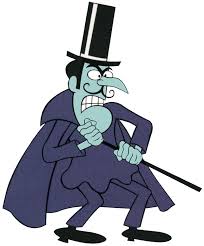
This tale has only blessed the screen 3 times but I think the heavy melodrama would have presented it more often (everyone loves a Snidely Whiplash)
1921 The Solitary Cyclist short theater movie in Eille Norwood’s Adventures of Sherlock Holmes with Hubert Willis as Watson. The National Film and Television Archive at the BFI has viewing copies of this film but it has not been released
1968 The Solitary Cyclist as a TV series episode with Peter Cushing as Holmes and Nigel Stock as another appearance as Dr. Watson. The episode has been lost.
1984 The Solitary Cyclist in the Granada/BBC series with Jeremy Brett and Davis Burke as Dr. Watson
SHERLOCK HOLMES IN DISGUISE
The Master of disguise used the deception of being disguised 14 times in 11 of the 60 stories, but not in this one.
UNRECORDED CASES (That involved Holmes)
Watson would tease / torture his readers with “I know something you don’t.” Oh my, how Sherlockians love this category. I have in excess of over 150 examples in my collection.
- The peculiar persecution of John Vincent Harden, the tobacco millionaire
- Archie Stamford, the forger
FAINTING IN THE CANON (courtesy of Sherlockian Karen Murdock)
Fainting is extremely common in the Canon, appearing, in some form, in 37 of the 60 tales. In 21 cases someone actually faints. In 22 cases someone almost faints. And in 5 cases someone pretends to faint. In this month’s story our heroine, Violet Smith, almost faints in this story.
HOLMES’S PUBLISHED & PROJECTED WORKS
Sherlockians love this topic and are regularly searching for these items. Holmes mentions published or projected works in 11 of the stories, but not in this one.
IS THERE A DOCTOR IN THE HOUSE?
Victorian London, in the Holmes’ time, had approximately 1 doctor for every 100 people. 31 of the 60 tales have a doctor in them. This, of course, does not count Holmes’ Boswell. This listing is by Leslie Klinger in the Winter, 2015 edition of the Baker Street Journal. In this story there was no doctor involved or mentioned.
NEWSPAPERS (Real and Fictional)
Though included in only 20 tales some of our more obsessed Sherlockians love this one. No mention of the press by name in this tale.
ANNOTATED SHERLOCK
The 60 Sherlock Holmes stories used English as spoken in England from the 1880’s until the 1910’s. Some words are foreign to us today and need a “contemporary translation.”. For example, our story has
. . . “ménage” French: the persons taken collectively who occupy one house; a household
. . . “grange” is a farmhouse with outbuildings
. . . “leather cords” leather corduroy breeches
WEAPONS (from A Compendium of Canonical Weaponry by Dettman and Bedford)
… “a means by which one contends against another” … utilized in 57 of the 60 tales (all but CREE, 3STU, & YELL) There are several general categories to classify “weapons” that include: firearms, human agents, cutlery, animals, blunt instruments, extortion, toxin, blackmail, and miscellaneous. In our story, which is short, you will find the following:
- Revolver – Sherlock Holmes’ and is mentioned in 8 cases. To cover Williamson and Carruthers.
- Pistol – Which Bob Carruthers used to would Roaring Jack Woodley after the surly ruffian forced Violet Smith to marry him.
- Pistol – Which Williamson, the ex-clergyman who performed the mock wedding, pulled on Carruthers after the latter’s wounding of Woodley.
- Riding Crop – Which Jack Woodley used to knock out the driver of Carruther’s trap carrying Violet Smith, and which was probably used to force her into marrying him.
- Hands – Of Sherlock Holmes used on Roaring Jack Woodley.
- Fist – Of Jack Woodley, which he used to knock down Bob Carruthers in the latter’s own home. Also, with it he was able to land a lucky punch on Holmes’ forehead, before the Master floored him with a straight left.
 Frank Mentzel, aka Merridew of Abominable Memory, has been catching up on reading some of the books he has ordered of late and is happy that it is now cooler than last week’s high temperatures.
Frank Mentzel, aka Merridew of Abominable Memory, has been catching up on reading some of the books he has ordered of late and is happy that it is now cooler than last week’s high temperatures.

